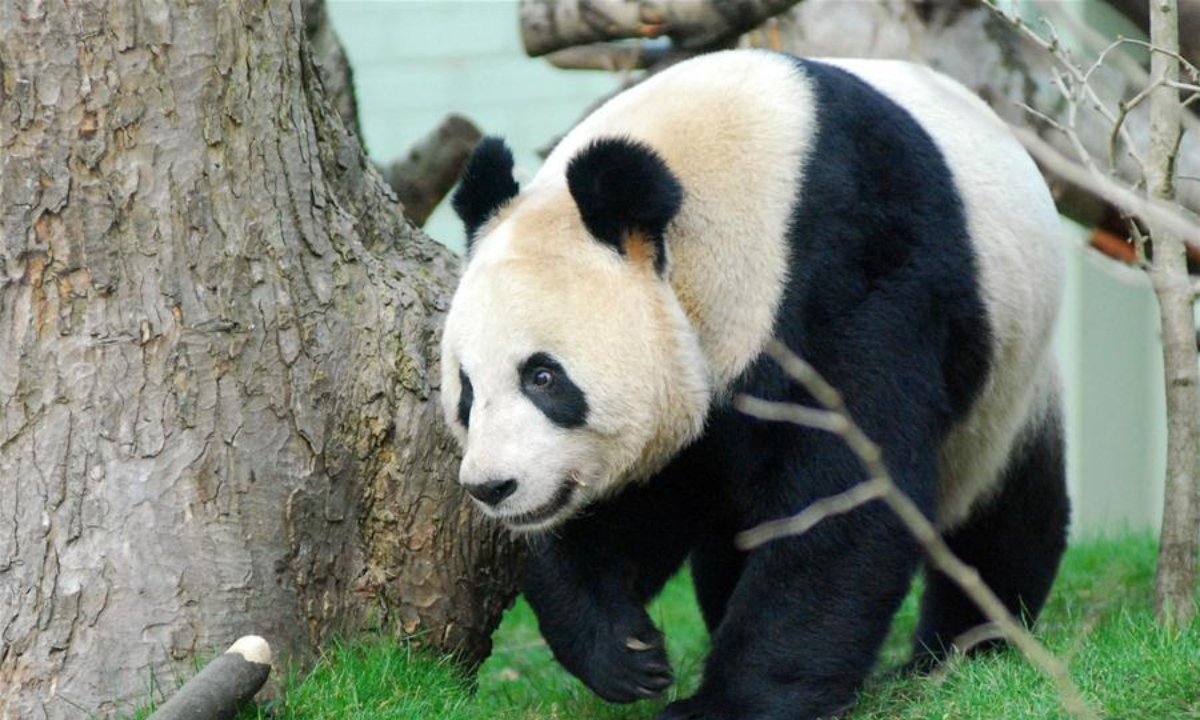
An undated photo provided by Edinburgh Zoo shows giant panda Tian Tian at Edinburgh Zoo, Scotland. Photo:Xinhua
On Tuesday morning, the two giant pandas Yang Guang and Tian Tian who had been living in the UK since 2011 safely arrived at Chengdu Shuangliu Airport in Southwest China's Sichuan Province. Chinese netizens warmly welcomed the return of the two pandas.
"Welcome back, our cutest ambassadors! Hope that they will have a happier and more contented life back in China," a netizen said. The topic of the two pandas' return has been highly discussed on Weibo and appeared among the top trending searches.
Last week, before their return to China, visitors bid farewell to Yang Guang and Tian Tian for the last time in the UK. "For me, pandas represent China. China is willing to lend pandas to other countries so that people around the world have the opportunity to see them. This brings joy and is an act of goodwill," a British resident said to media outlets.
In December 2011, as part of an agreement between the Royal Zoological Society of Scotland and the China Wildlife Conservation Association, Yang Guang and Tian Tian were loaned to Edinburgh Zoo for 12 years. The Royal Zoological Society of Scotland stated that over 1 million species are facing the risk of extinction, and against this backdrop, Yang Guang and Tian Tian have inspired millions of people to care about nature and have had an incredible impact.
According to Edinburgh Zoo staff, in order to help the pandas adapt to the environment inside the crates during the journey, the zoo had conducted adaptive training in advance. In addition, they thoughtfully prepared "in-flight meals" for the two passengers - fresh bamboo grown in the UK. At around 9:45 am on Monday, the truck slowly drove out of the zoo's gate, and Yang Guang and Tian Tian headed to Edinburgh Airport, officially embarking on their journey back home.
Royal Zoological Society Scotland Chief Executive David Field said it was a sad day for staff and visitors alike. He said, "It's sad not just for our keepers, but our members, our visitors and all those people who have watched them on pandacam."
Regarding the return of the giant pandas Yang Guang and Tian Tian, Chinese Foreign Ministry spokesperson Wang Wenbin stated on December 1 that since the international cooperation on giant panda conservation research between China and the UK began in 2011, a good cooperative relationship has been established. Positive achievements have been made in giant panda conservation management, scientific research, technological exchange, and public education, playing an important role in enhancing mutual understanding and friendship between the Chinese and British people.
The female giant panda Tian Tian was once selected as the "2011 Female Face" by the BBC.
Since the return of the giant panda cub Xiang Xiang on February 21 from Japan, a total of 15 giant pandas have returned to China this year from countries including the US, France, Japan, the Netherlands, Malaysia, and the UK.
In September, Singapore announced that the giant panda cub Le Le, the first panda cub born in Singapore, will return to China in December. If Le Le returns to China as scheduled, a total of 16 overseas pandas will have returned home in 2023.
These pandas are returning home this year because agreements have expired, but in some cases their return was delayed until this year due to the impact of the COVID-19 pandemic, which has resulted in this unusually large "group return."
For example, Xiang Xiang was originally scheduled to return to China at the end of December 2020, but due to the pandemic, the return was delayed until this year. Yang Guang and Tian Tian were also scheduled to return home two years ago but the deal was extended due to the pandemic.
Experts said that over the years, the international partners in giant panda protection have jointly overcome a series of technical challenges in the fields of giant panda conservation, breeding, disease prevention and control, and reintroduction into the wild. A large number of highly valuable scientific papers and works have been published, which have not only significantly improved the health and breeding capacity of captive giant pandas, optimized the captive population structure, and increased genetic diversity, but also significantly enhanced technological support for the protection of giant pandas and their habitats.
Through international cooperation projects, training on the conservation of endangered wildlife such as giant pandas has been provided to thousands of people, cultivating a large number of professional and technical personnel and core staff, while also improving the overall level of global wildlife conservation. Foreign visitors can learn about the effectiveness of giant panda conservation, listen to stories about giant panda protection, experience Chinese ecological culture, and enhance cultural exchanges and public education between China and other countries.




